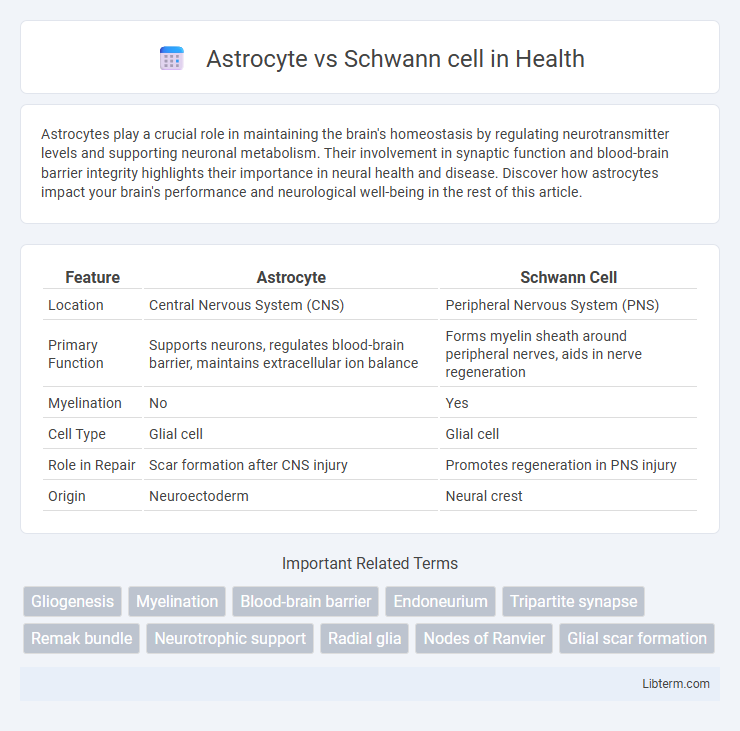Astrocytes play a crucial role in maintaining the brain's homeostasis by regulating neurotransmitter levels and supporting neuronal metabolism. Their involvement in synaptic function and blood-brain barrier integrity highlights their importance in neural health and disease. Discover how astrocytes impact your brain's performance and neurological well-being in the rest of this article.
Table of Comparison
| Feature | Astrocyte | Schwann Cell |
|---|---|---|
| Location | Central Nervous System (CNS) | Peripheral Nervous System (PNS) |
| Primary Function | Supports neurons, regulates blood-brain barrier, maintains extracellular ion balance | Forms myelin sheath around peripheral nerves, aids in nerve regeneration |
| Myelination | No | Yes |
| Cell Type | Glial cell | Glial cell |
| Role in Repair | Scar formation after CNS injury | Promotes regeneration in PNS injury |
| Origin | Neuroectoderm | Neural crest |
Introduction to Astrocytes and Schwann Cells
Astrocytes are star-shaped glial cells in the central nervous system that support neurons by regulating the blood-brain barrier, maintaining extracellular ion balance, and facilitating nutrient transport. Schwann cells are glial cells in the peripheral nervous system responsible for myelinating axons, which speeds up electrical signal conduction and aids in nerve regeneration. Both cell types play crucial roles in nervous system function but differ fundamentally in location and specific physiological functions.
Origins and Developmental Pathways
Astrocytes originate from neuroectodermal stem cells in the central nervous system and develop through gliogenesis guided by signaling pathways such as Notch and STAT3. Schwann cells arise from neural crest cells in the peripheral nervous system, undergoing a migration and differentiation process influenced by neuregulin-1 and the ErbB receptor family. The distinct embryonic origins and molecular signals dictate their specialized roles in CNS support and PNS myelination, respectively.
Structural Differences
Astrocytes possess star-shaped, highly branched processes that extend to cover blood vessels and neurons in the central nervous system, providing structural support and maintaining the blood-brain barrier. Schwann cells are elongated, cylindrical glial cells that wrap around peripheral nerve axons to form myelin sheaths, essential for rapid nerve impulse conduction. Unlike astrocytes, Schwann cells produce discrete myelin segments along individual axons, reflecting their specialized role in peripheral nervous system insulation and regeneration.
Key Functions in the Nervous System
Astrocytes regulate the blood-brain barrier, maintain extracellular ion balance, and support neuronal metabolism in the central nervous system. Schwann cells facilitate rapid nerve impulse conduction by myelinating peripheral nerve fibers and aid in nerve regeneration after injury. Both cell types are crucial for maintaining neural environment stability and ensuring efficient signal transmission.
Role in Myelination
Astrocytes primarily support the central nervous system (CNS) by maintaining the blood-brain barrier and regulating extracellular ion balance but do not directly participate in myelination. Schwann cells are responsible for myelination in the peripheral nervous system (PNS), wrapping axons with myelin sheaths that facilitate rapid nerve impulse conduction. The fundamental distinction lies in Schwann cells' role in insulating peripheral nerves, whereas astrocytes contribute to CNS structural and metabolic support without forming myelin.
Response to Neural Injury
Astrocytes in the central nervous system form a glial scar after neural injury, regulating inflammation and promoting tissue repair by releasing neurotrophic factors and cytokines. Schwann cells in the peripheral nervous system actively participate in axonal regeneration by dedifferentiating, proliferating, and guiding regrowth through the formation of Bands of Bungner. The differential response of astrocytes and Schwann cells highlights their distinct roles in neural repair mechanisms across the CNS and PNS.
Involvement in Neurological Disorders
Astrocytes play a critical role in the progression of neurological disorders such as Alzheimer's disease and multiple sclerosis by modulating neuroinflammation and maintaining blood-brain barrier integrity. Schwann cells contribute to peripheral neuropathies and are involved in nerve regeneration processes after injury, but their dysfunction can lead to conditions like Charcot-Marie-Tooth disease. Dysregulation of astrocyte and Schwann cell functions directly impacts neuronal survival and repair mechanisms in central and peripheral nervous system disorders.
Molecular and Genetic Distinctions
Astrocytes express GFAP (glial fibrillary acidic protein) and S100b, crucial for CNS support and neurovascular coupling, while Schwann cells uniquely produce myelin proteins such as P0 and PMP22 essential for peripheral nerve myelination. The gene expression profiles highlight distinct transcription factors, with astrocytes showing high levels of NFIA and Sox9 that regulate CNS glial differentiation, whereas Schwann cells rely on Krox20 (EGR2) and Sox10 for peripheral myelination gene regulation. These molecular and genetic distinctions underpin their specialized functions in maintaining neural homeostasis and facilitating nerve regeneration in their respective central and peripheral nervous system environments.
Implications for Regenerative Medicine
Astrocytes and Schwann cells play distinct roles in nervous system repair, with astrocytes primarily supporting central nervous system regeneration by modulating inflammation and maintaining the blood-brain barrier, while Schwann cells facilitate peripheral nerve regeneration through myelination and axonal guidance. Schwann cells' capacity to promote axonal regrowth and remyelination makes them critical targets for therapies addressing peripheral nerve injuries. Harnessing the regenerative properties of both cell types offers promising strategies for developing cell-based treatments for neurodegenerative diseases and traumatic nerve damage.
Future Research Directions
Future research on astrocytes and Schwann cells aims to unravel their distinct roles in neuroregeneration and neuroinflammation, targeting molecular pathways for therapeutic intervention. Advanced techniques like single-cell RNA sequencing and in vivo imaging are expected to enhance understanding of cell-type-specific functions and plasticity in CNS and PNS repair. Exploring their interactions with neural stem cells and immune responses could lead to breakthroughs in treating neurodegenerative diseases and peripheral nerve injuries.
Astrocyte Infographic

 libterm.com
libterm.com